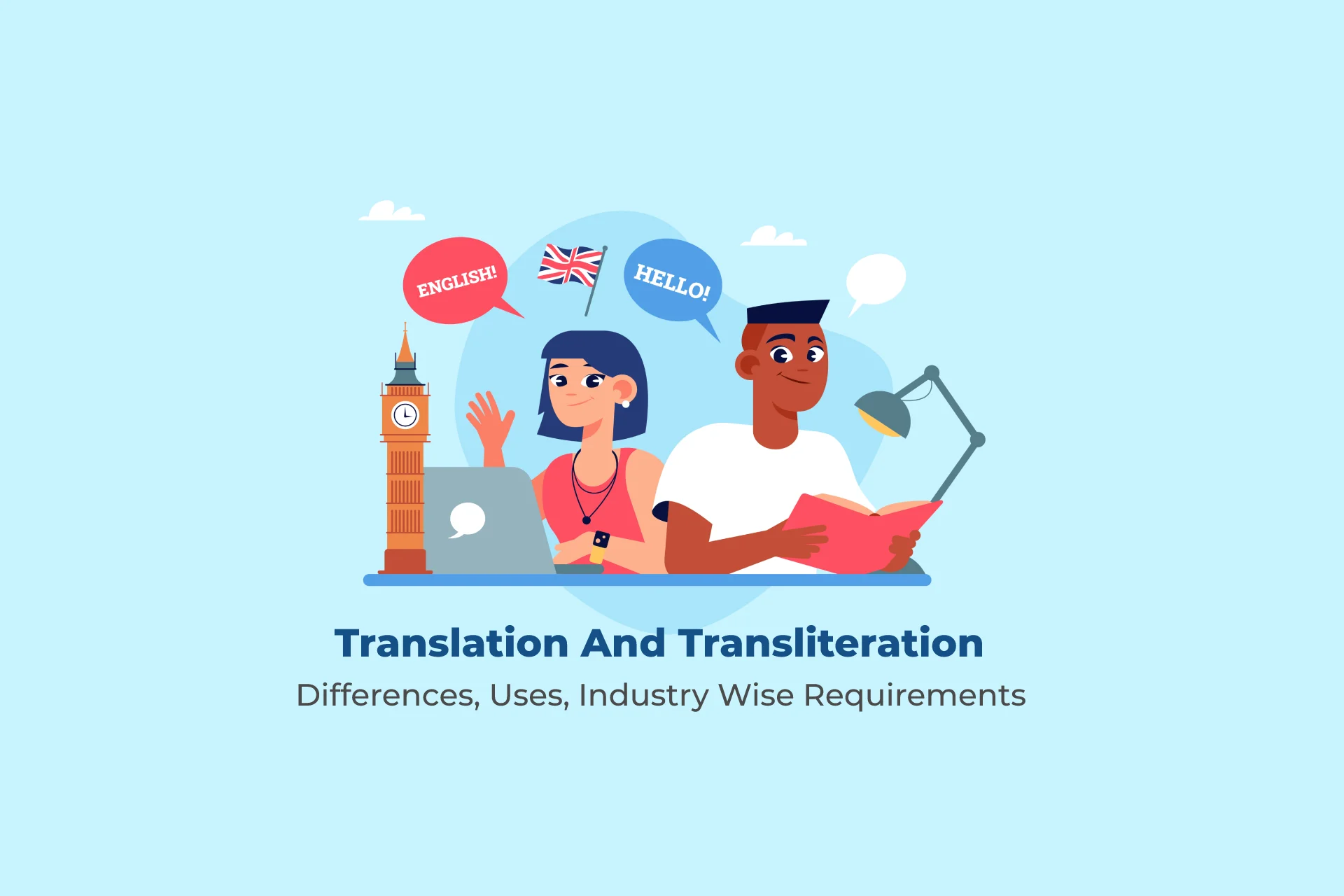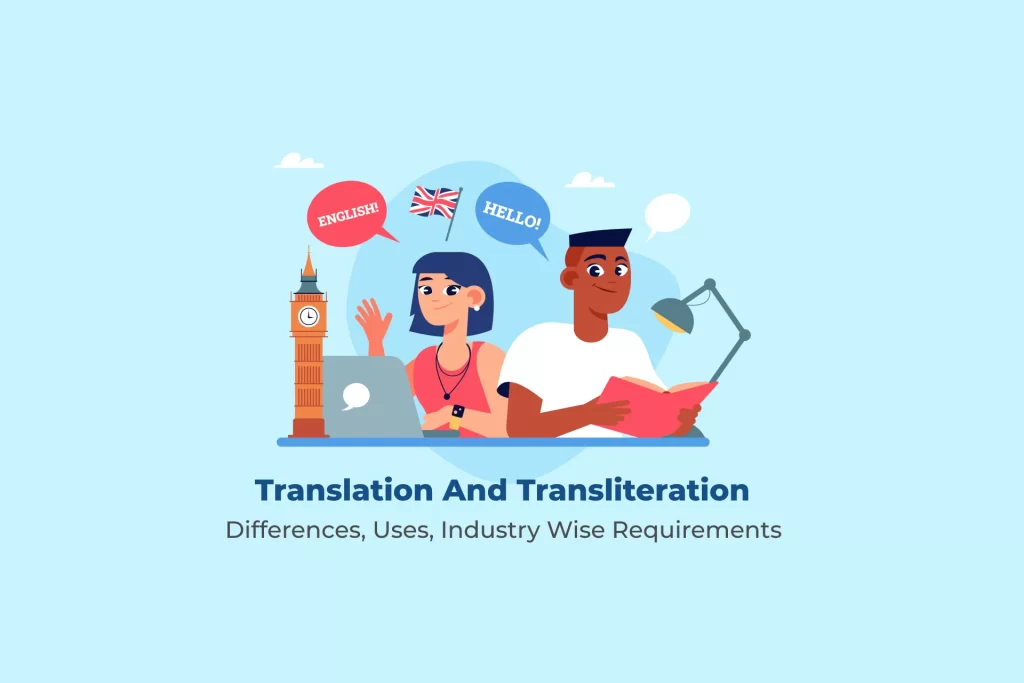Translation and Transliteration
As we all know it, the act of converting words or sentences from one language into another is known as Translation. But do you know what Transliteration means? More so, did you ever find yourself confused between the two?
Well, this is quite a common doubt that often arises among many.
You need not worry. We have come up with information that will clear all your doubts and help you learn the difference between Translation & Transliteration.
Now, even when both the terms seem like they mean the same, they are actually not. There’s a huge difference between the two.
Let us start with it.
The key distinctions between Translation and Transliteration are listed below:

Meaning and Interpretations:
Translation:
The idea of Translation is to transfer the meanings of a particular linguistic discourse from the source language to the targeted language.
In other words, a text’s comparable meaning must be found in the target language during Translation. Here, the emphasis is on translating statements’ original meaning into the target language.
Here’s an example:
Hindi: मुझे लाल रंग पसंद है।
English: I love the color red.
Transliteration: Transliteration is the process of communicating a word or phrase in a language different from the source language using a different writing system.
A transliteration may not necessarily tell you the meaning of the word. Still, it gives you an idea of how the word is pronounced in a foreign language.
Here’s an example:
Hindi: मैं पढ़ाई कर रहा हूं
English: Main Padhai Kar Raha hun
Application of the two terms (Translation VS Transliteration):
Transliteration: Transliteration is the process of communicating a word or phrase in a language different from the source language using a different writing system.
A transliteration may not necessarily tell you the meaning of the word. Still, it gives you an idea of how the word is pronounced in a foreign language.
There are a lot of legal reports, documents, and articles that need to be translated into different languages depending on the requirement.
Translation does not only limit to documents and reports, but as general content, it is extremely beneficial when a larger set of audience is expected to access the content, so people can read it in the language they are familiar with.
Transliteration: When foreign people, places, and cultures are discussed or studied, Transliteration can be useful.
Transliteration is, therefore, necessary if you are required to read literature written in a language other than your own and prefer to pronounce the words to comprehend them.
You might have noticed Transliteration used in menus of Cafes and Restaurants, In Dictionaries that help with the pronunciation, in research papers, and on various other platforms where accent & speech delivery are important.
Character change
Translation: Since characters have no role to play in the process of Translation but rather the meaning of the word/phrase, the characters are completely changed.
Here’s an example:
Hindi: फूल
English: Flower
Transliteration: Here, a character/letter from the word is Transliterated into its equivalent character/letter from the target language.
Here’s an example:
Hindi: फूल
English: Phool
Meaning change
Translation: The translated sentence/phrase’s meaning stays the same as the source text’s.
Transliteration: The transliterated phrase’s meaning may or may not necessarily be the same as the source text’s.
Objective
Translation: The main objective of Translation is to fit the intended message clearly into the targeted (translated) language.
Transliteration: The purpose of Transliteration is to keep a word uninterpreted, constant and unchanged with respect to its pronunciation.
FAQs Related to Translation VS Transliteration
What does transliteration mean in English?
Transliteration is the process of converting a word or text from one writing system to another. In this process, the sounds of the original word or text are retained, but they are represented using the characters of another writing system.
For example, if you wanted to transliterate the Hindi word “दोस्त” into English, you might write it as “dost.” The sounds of the Hindi word are retained, but they are represented using the characters of the English writing system.
Transliteration is different from translation, which involves converting the meaning of a word or text from one language to another. Transliteration is often used when writing foreign names or words in a language that uses a different writing system, to help the reader to pronounce the word correctly.
What are the 4 types of translation?
There are different ways to categorize types of translation, but one common classification is based on the degree of freedom that the translator has in the process. Here are four types of translation based on this classification:
- Literal translation: Also known as word-for-word translation, this type of translation follows the source text closely and reproduces its words and structure as closely as possible. Literal translation is often used for technical or legal texts, where precision and accuracy are crucial.
- Faithful translation: This type of translation aims to reproduce the meaning and tone of the source text as accurately as possible, while still adjusting the language and structure to fit the target audience. Faithful translation may require some rephrasing or adaptation of idioms and cultural references, but it strives to maintain the spirit of the original text.
- Adaptation: In this type of translation, the translator takes more liberties with the source text and may change elements of it to suit the target audience or cultural context. Adaptation is often used for creative works like literature or film, where the translator may need to modify the plot, characters, or setting to make the work more accessible or relevant to the target audience.
- Free translation: This type of translation is the most flexible and may depart significantly from the source text to convey its meaning in a way that works for the target audience. Free translation may use paraphrasing, summarizing, or even creative writing techniques to convey the essence of the source text, rather than reproducing it directly.
It’s important to note that these types of translation are not always mutually exclusive, and many translations may combine elements of different types depending on the specific needs of the project.
Translation vs Transliteration vs Transcription
Translation, transliteration, and transcription are all related to language and text, but they refer to different processes. Here are brief explanations of each:
- Translation: Translation involves converting the meaning of a text from one language to another. The translator analyzes the source text, understands its meaning, and reproduces that meaning in the target language. Translation may involve adjusting the language and structure of the text to fit the target audience or cultural context.
- Transliteration: Transliteration involves converting the characters of one writing system to another, while retaining the sounds of the original text. The transliteration process may involve substituting each character of the original writing system with a corresponding character in the target writing system, or it may involve using a phonetic system to represent the sounds of the original text.
- Transcription: Transcription involves converting spoken language into written language, often using a phonetic system to represent the sounds of the spoken words. Transcription may be used for language learning, linguistic analysis, or to create written records of spoken communication.
It’s important to note that these processes are not always mutually exclusive and may overlap in some cases. For example, when translating a text from a language that uses a non-Latin writing system to a language that uses the Latin alphabet, transliteration may be used to represent the original text in the Latin alphabet before translating it. Similarly, when transcribing spoken language from one language to another, the transcription may need to be translated to convey its meaning accurately.
Read out some more related frequently asked questions here CLICK HERE
Translation vs. Transliteration: Importance
Now that we have cleared your doubts on both terms, it can be said there is no definite need for a comparison between the two since they serve different meanings, usages, and intended purposes.
Each of these terms contributes in a different way to the conversion of the source language into the target language.
To have a strong presence of one’s organization in the global market, it is advisable to have one’s documents and other important content translated into the languages used by the countries one wishes to expand their business in. We have a team of expert translators to assist you with your business needs.
Translation & Transliteration are both equally important in their respective areas. A linguist must be proficient in various transliterations, whatever language it may be.
This comes in handy when a Businessman must speak in the native language of the region he is supposed to address if he is well-versed in Transliteration.
Click on the titles to learn more about similar topics: Localization (FAQs), Voiceover (FAQs), Transcription (FAQs), and Interpretation (FAQs)
Want to know how Govt of India works with translation requirements, click & check out the website of the Central Translation Bureau or visit ctb.rajbhasha.gov.in
Whether you are stuck or need a translator, our team is ready to assist you with all your requirements. Click & check out the translation services section on our website. You can reach out to us via email (sales.nsweblabs@gmail.com) or the chat option on our website.
